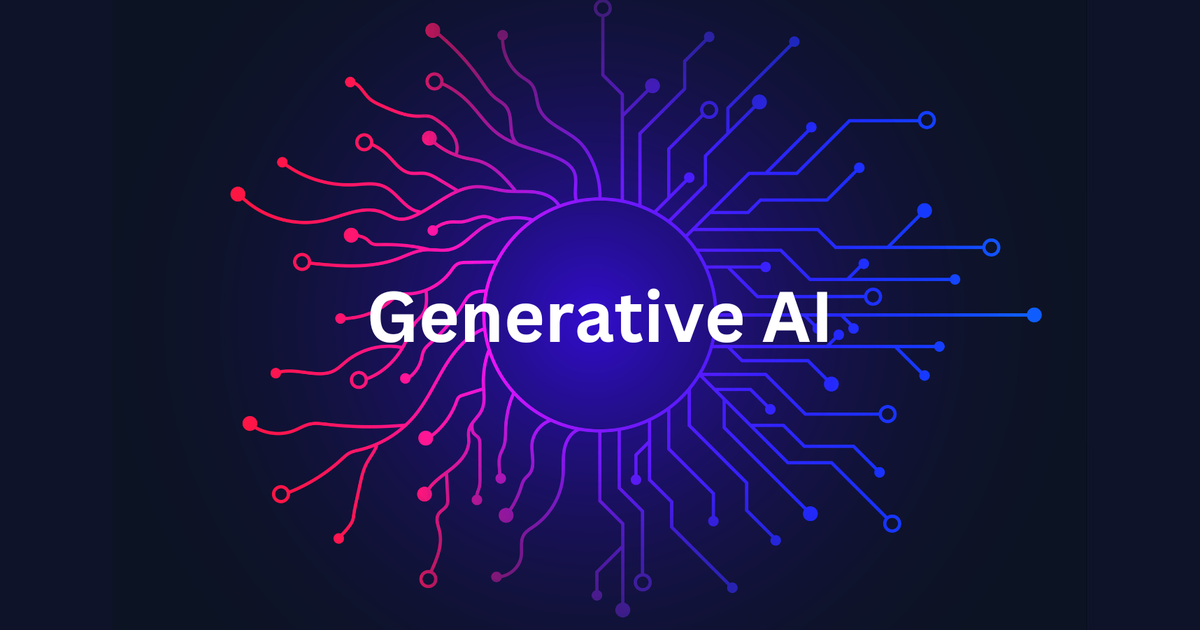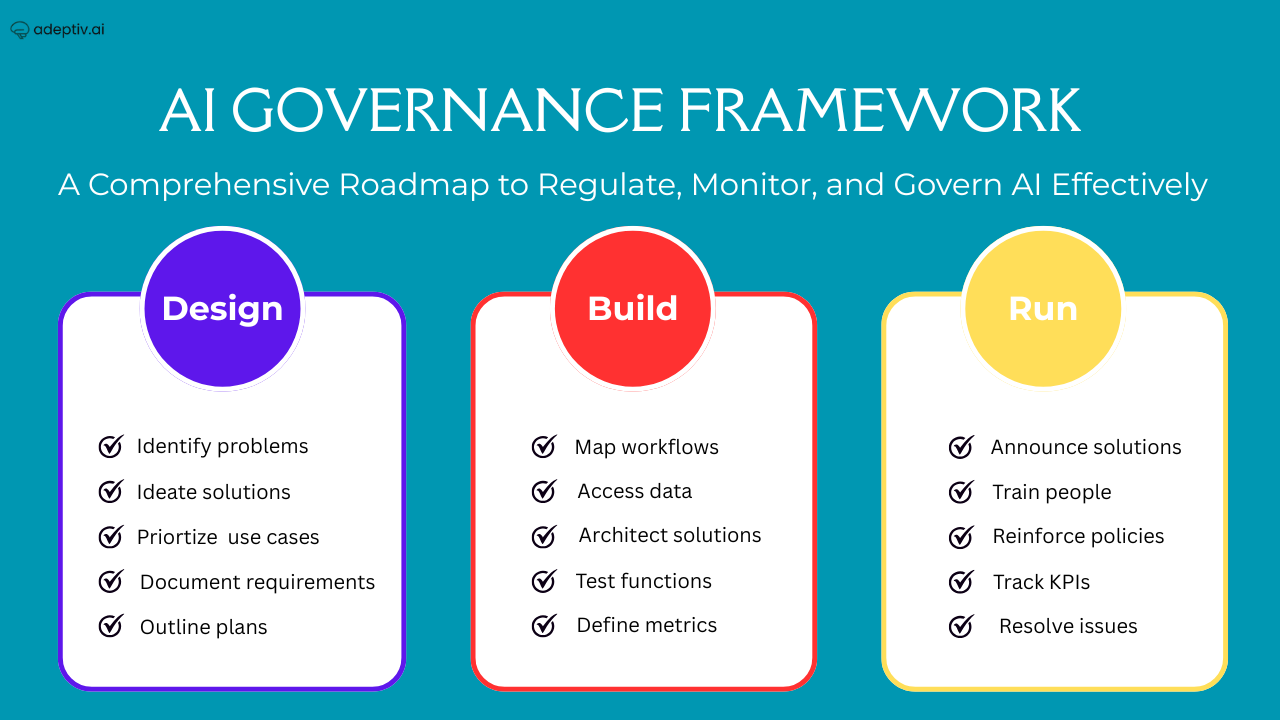At a Glance
- Generative AI enables enterprises to create text, images, videos, and code using advanced ML models.
- Leading companies like IBM, Google, OpenAI, and Adobe are leveraging AI for efficiency, innovation, and creativity.
- Applications span marketing, healthcare, finance, design, and software development.
- 2025 advancements include multimodal AI, synthetic data, edge AI, and enterprise integration platforms.
- Ethical challenges such as bias, IP ownership, deepfakes, and privacy require responsible governance.
- Adeptiv AI’s Responsible AI Framework provides tools to assess, govern, and ensure compliant AI adoption.
Introduction: The Rise of the Creative Machine
Generative AI has evolved from a research concept into one of the most disruptive forces in enterprise technology. Using advanced machine learning models such as GPT, DALL·E, and Gemini, AI systems now generate human-like text, images, videos, and even software code.
According to McKinsey’s 2025 AI Report, over 80% of organizations are integrating generative AI into their operations, with potential productivity gains exceeding $4.4 trillion annually. The message is clear: Generative AI is no longer an experiment—it’s a business imperative.
What is Generative AI?
Generative AI refers to algorithms capable of producing new content—text, images, audio, or data—based on training from massive datasets. Unlike traditional AI, which classifies or predicts, generative AI creates.
Key technologies behind Generative AI:
| Core Model | Description | Example Tools |
| Transformer Models | Deep neural networks that understand context and language | GPT-4, Google Gimini |
| Diffusion Models | Generate realistic visuals through interactive refinement | DALL-E, Midjourney |
| GANs (Generative Adversarial Networks) | Competing neural networks to improve image quality. | Runway ML, NVIDIA StyleGAN |
| Large Language Models (LLMs) | Advanced NLP models for reasoning, writing, and dialogue | ChatGPT, Claude, Gemini |
Applications Across Industries
Generative AI has moved beyond novelty into mission-critical use cases across multiple sectors.
1. Marketing & Content Creation
Brands like Coca-Cola and Nike are using AI to design ad visuals, write copy, and personalize customer engagement.
Stat: HubSpot reports that 73% of marketers plan to increase AI integration by 2026.
2. Healthcare & Life Sciences
Generative AI accelerates drug discovery, medical imaging, and patient personalization. Insilico Medicine, for instance, discovered a novel drug compound using AI in 45 days—compared to the traditional 6–12 months.
3. Financial Services
Banks like JPMorgan and Goldman Sachs leverage AI for risk modeling, fraud detection, and report generation. AI enables predictive insights while cutting manual effort by 30–40%.
4. Design, Media & Entertainment
Adobe Firefly and Runway ML empower designers to co-create content faster, while Hollywood studios explore AI-assisted storyboarding and CGI.
5. Software Development
GitHub’s Copilot and Google’s Codey revolutionize programming—suggesting real-time code completions and boosting developer productivity by 55%.
Recent Advancements: The 2025 AI Breakthroughs
- Multimodal AI Systems: Google’s Gemini and OpenAI’s GPT-5 can interpret and generate across text, image, and video simultaneously.
- Enterprise Integration Platforms: AWS and Microsoft Azure launched AI orchestration tools allowing enterprises to safely deploy and monitor AI models at scale.
- AI-Generated Data for Model Training: Synthetic data is emerging as a powerful tool to fill data gaps while maintaining privacy compliance.
- Edge AI Deployment: Companies like NVIDIA are enabling generative models to run directly on devices—reducing latency and cost.
Ethical Considerations and Responsible AI
As innovation accelerates, so do the risks—bias in data, misinformation, and regulatory non-compliance.
Key Ethical Challenges:
| Risk Type | Description | Example |
| Data Bias | Inaccurate or unbalanced data leading to discrimination | Hiring algorithms unfairly filtering candidates |
| Deepfakes & Misuse | Fake identities or content creation | AI-generated political misinformation |
| IP Ownership | Ambiguity over content rights | Artists vs. AI-generated artwork disputes |
| Privacy Violations | Sensitive data exposure in outputs | Chatbots revealing user data |
Adeptiv AI’s Responsible AI Framework
At Adeptiv AI, we believe governance is the cornerstone of sustainable innovation. Our Responsible AI Framework empowers enterprises to:
- Assess model risk across data, ethical, and operational layers
- Implement robust AI governance and compliance structures
- Ensure ethical deployment aligned with global regulations like the EU AI Act and US NIST AI RMF
Future Trends: The Next Frontier of Generative AI
- AI-Powered Agents: Autonomous agents capable of performing multi-step business processes.
- Hyper-Personalized Customer Experience: From retail to banking, AI will predict needs before customers express them.
- AI Governance Integration: Responsible AI adoption will become a legal requirement, not a choice.
- Creative-AI Synergy: Human creativity enhanced—not replaced—by AI tools.
Case Study: Adobe’s Responsible Innovation
Adobe Firefly introduced “Content Credentials”—metadata tags that track AI-generated content origins. This transparent model became a benchmark for ethical AI deployment, influencing frameworks like the EU AI Act.
Conclusion
Generative AI is rapidly transforming enterprise operations, from automating creative processes to optimizing complex workflows. Organizations that adopt AI responsibly—balancing innovation with ethics and governance—are better positioned to drive growth, maintain compliance, and enhance stakeholder trust.
Frameworks like Adeptiv AI’s Responsible AI solution ensure businesses can deploy Generative AI safely and effectively, addressing ethical, operational, and regulatory challenges while unlocking the technology’s full potential.
FAQs
1. What is Generative AI?
Generative AI refers to algorithms that can create new content—text, images, audio, or code—based on patterns learned from large datasets. It differs from traditional AI, which predicts or classifies data.
2. Which industries benefit most from Generative AI?
Industries like marketing, healthcare, finance, media, design, and software development leverage Generative AI for productivity, innovation, and personalization.
3. What are the key ethical challenges in Generative AI?
Challenges include data bias, deepfake content, IP disputes, and privacy violations. These risks necessitate careful governance and compliance measures.
4. How can enterprises implement responsible AI?
Using frameworks like Adeptiv AI’s Responsible AI Framework, organizations can assess risks, enforce ethical policies, and comply with global regulations such as the EU AI Act and NIST AI RMF.
5. What are future trends in Generative AI?
Expect AI-powered agents, hyper-personalized experiences, integrated AI governance, and human-AI creative collaboration to dominate enterprise adoption in the coming years.



